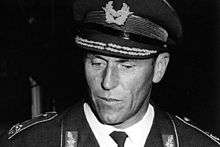Hannes Trautloft
| Hannes Trautloft | |
|---|---|
 Trautloft in 1963 | |
| Born | 3 March 1912 |
| Died | 11 January 1995 (aged 82) |
| Allegiance |
|
| Service/ |
Luftwaffe German Air Force |
| Years of service |
1932–45 1957–70 |
| Rank | Generalleutnant |
| Commands held | JG 54 (Luftwaffe) |
| Battles/wars | World War II |
| Awards | Knight's Cross of the Iron Cross |
Johannes "Hannes" Trautloft (3 March 1912 – 11 January 1995) was a German general and Deputy Inspector of the Air Force of West Germany. During World War II, he was a fighter pilot in the Luftwaffe of Nazi Germany.
Early life
Hannes Trautloft was born in Großobringen near Weimar, Thuringia. On 7 April 1931, he began his pilot training at the Deutsche Verkehrsfliegerschule, a covert military training organization operating as a flying school. He studied with 29 other men who included Wolfgang Falck and Günther Lützow, graduating in February 1932. Trautloft and nine others were recommended for training at the Lipetsk fighter-pilot school in the Soviet Union.[1]
World War II
Trautloft took part in the Battle of France in May 1940. In late August it was becoming apparent to the German High Command that the battle of Britain was not going as planned. A frustrated Hermann Göring, head of the Luftwaffe, relieved several wing commanders, and appointed younger, more aggressive men in their place.[2] On 6 July 1943 Trautloft was appointed as Jagdflieger Inspizient Ost, serving with the General der Jagdflieger office. This position put him in overall charge as Inspector of all the Fighter aircraft units fighting on the Eastern Front. In November he became Inspekteur der Tagjäger, giving him overall responsibilities for all day-fighters.
On 20 August 1944 inmates of various detention camps and centres in occupied France were deported to Buchenwald concentration camp, among them 168 Allied airmen. For some time it remained uncertain what was to be done with them. On 19 October 1944 the majority were taken to the prisoner-of-war camp of the German Air Force Stalag Luft III in Sagan.[3] After the war some of the airmen recounted that officers of the German Air Force had visited Buchenwald a few days after an Allied air raid on Weimar in late August 1944 to assess the damage inflicted upon the armament factory adjacent to the camp. According to these recollections the German officers talked to the airmen and saw after it that they were transferred to the POW camp.[4] Years later veterans identified Johannes Trautloft from photos as one of the officers and credited him with saving their lives.[5] Until now it was not possible to verify this story with archival records, including Trautloft's war diary.[5] The Gedenkstätte Buchenwald stated that a visit by Trautloft or others might have happened and that this might have influenced the decision making process what to do with the airmen. On the other hand, there might have been no connection whatsoever, because the decisions were not made by a single officer like Trautloft.[5]
After World War II
After the war Trautloft joined the new German Air Force of West Germany on 1 October 1957, now with the rank of Brigadegeneral. He served throughout the 1960s as deputy Inspector General of the Air Force, and retired in 1970 as a Generalleutnant. He was an active member of many veteran organizations including the Gemeinschaft der Jagdflieger until his death on 11 January 1995 at Bad Wiessee.
Awards
- Knight's Cross of the Iron Cross on 27 July 1941 as Major and Geschwaderkommodore of Jagdgeschwader 54>[6]
- German Cross in Gold on 27 July 1942 as Major in Jagdgeschwader 54[7]
References
Citations
- ↑ Kurt Braatz, pp. 28–51
- ↑ Deighton, Fighter: The True Story of the Battle of Britain, p.182
- ↑ Gedenkstätte Buchenwald, ed. (2004). Buchenwald Concentration Camp, 1937–1945: A Guide to the Permanent Historical Exhibition. Harry Stein. Göttingen: Wallstein Verlag. p. 171. ISBN 978-3-89244-695-8.
- ↑ Burgess, Colin (1995, p. 133). Destination Buchenwald. Published by Kangaroo Press, Kenthurst NSW. OCLC 35019954. ISBN 0-86417-733-X; Moser, Joseph and Baron, Gerald (2009, p. 122). A fighter pilot in Buchenwald. Published by Edens Veil Media, Bellingham, WA. OCLC 311551716. ISBN 978-0-615-22111-3; Kinnis, Arthur and Booker, Stanley (1999, p. 176). 168 Jump Into Hell. Published by Victoria B.C. OCLC 43390724. ISBN 0-9684198-0-1
- 1 2 3 Biskup, Harald (2014-03-12). "US-Piloten im KZ Buchenwald: Letzter Kampf für den Retter" [US-Airmen in Buchenwald Cconcentration Camp: Last Fight for the Rescuer]. Kölner Stadt-Anzeiger. Cologne. Retrieved 2018-06-27.
- ↑ Scherzer 2007, p. 749.
- ↑ Patzwall & Scherzer 2001, p. 479.
Bibliography
- Deighton, Len (1977). Fighter: The True Story of the Battle of Britain, Pimlico. ( ISBN 0-7126-7423-3)
- Kurt Braatz (2005), Gott oder ein Flugzeug - Leben und Sterben des Jagdfliegers Günther Lützow. NeunundzwanzigSechs Verlag. ISBN 3-9807935-6-7
- Forsyth, Robert (2011). Aces of the Legion Condor. Oxford, UK: Osprey Publishing. ISBN 978-1-84908-347-8.
- Patzwall, Klaus D.; Scherzer, Veit (2001). Das Deutsche Kreuz 1941–1945 Band II [The German Cross 1941–1945 Volume 2] (in German). Norderstedt, Germany: Verlag Klaus D. Patzwall. ISBN 978-3-931533-45-8.
- Scherzer, Veit (2007). Die Ritterkreuzträger 1939–1945 [The Knight's Cross Bearers 1939–1945] (in German). Jena, Germany: Scherzers Militaer-Verlag. ISBN 978-3-938845-17-2.
| Military offices | ||
|---|---|---|
| Preceded by Major Martin Mettig |
Commander of Jagdgeschwader 54 Grünherz 15 August 1940 – 5 July 1943 |
Succeeded by Major Hubertus von Bonin |
| Preceded by Oberst Günther Lützow |
Commander of 4. Fliegerschul-Division 10 November 1944 – 8 May 1945 |
Succeeded by none |